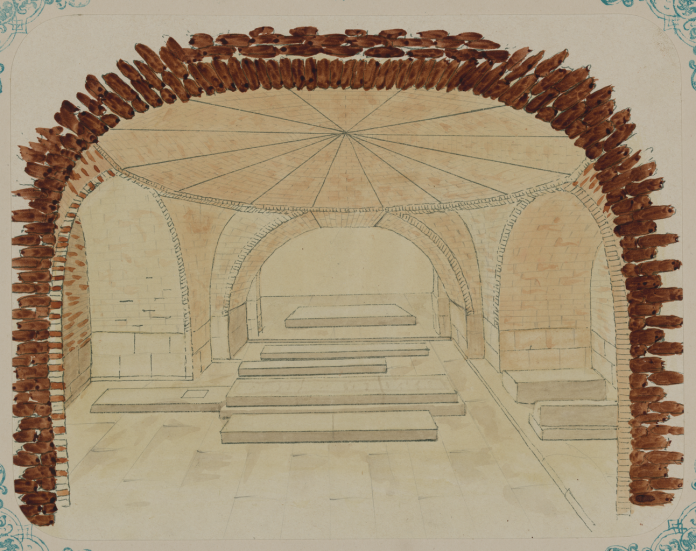The overlapping of several binary oppositions in the model of the world of ancient man could lead to four-membered complexes, for example, to the scheme of the “horizontal” model of orientation to the four cardinal directions.
The use of the sacred sign of the cross is associated with the archaic form of settlement in a number of later ancient Egyptian cultures (the hieroglyph for the designation of the settlement, which is a cross inscribed in a circle), South Asian, in the culture of American Indians, where this sign, as well as the symbolism of the sacred number 4, is especially widely represented.
Three-term divisions in the history of cultures begin to play a significant role later than two-term and four-term divisions based on them. The later primitive art (unlike the primitive Paleolithic) is characterized by the complication of images (animals, humans, solar and lunar symbols) around the central image of the world tree, in which three parts are always distinguished: the top, middle and roots. This image remains dominant in many traditions.
According to Plato, the difference between arithmetic as the science of numbers and geometry as the science of “figures” is that geometry represents numbers and numerical relations in the form of spatial bodies and figures. Numbers and geometric objects have different status for him, numbers are ideal entities, geometric shapes are “intermediate” entities. And objects that have the shape of a ball or cube are only sensory similarities of an ideal ball or cube, just as a drawing is only a sensory similarity of a geometric figure. By their status, geometric constructions differ both from the objects of the sensory world and from the ideal entities of numbers. Trying to find the ontological status of geometric objects, Plato for the first time introduces the concept of the geometric space of the element of geometry, a kind of medium between ideas and the sensory world.
Plato’s polyhedra are formulas of a certain way of organized space with all its three dimensions. Triangles act not only as spatial, geometric shapes, but they also delimit space, because it is space that is enclosed in regular polyhedra corresponding to the elements.
Such a structural-geometric, symbolic architectural understanding of space generates not only architectural abstractions (megalomaniacs in France of the XVIII century), but also leads to scientific philosophical generalizations of the picture of the world. This is possible precisely because of the conventionality and beyond the historicity of Platonic geometry figures as archetypes of spatial thinking. The ideas of the search for symmetry or harmony of the world, characteristic of astronomers, physicists, architects of Modern times, go back to them.
In his first work, The Mystery of the Universe (1597), Kepler tries to deduce from a single geometric principle the number of orbits, their relative sizes and the nature of the movement of the planets and thereby “reveal the plans of the creator himself.”
So, the geometry of the Solar System (the mystery of the universe”), according to Kepler, consists in the following construction: “The Earth (meaning the orbit of the Earth) is the measure of all orbits. We will describe a dodecahedron around it. The sphere described around the dodecahedron is the sphere of Mars. We will describe a tetrahedron around the sphere of Mars. The sphere described around the tetrahedron is the sphere of Jupiter. Around the sphere of Jupiter we describe a cube . The sphere described around is the sphere of Saturn. Let’s put an icosahedron into the sphere of the earth. The sphere inscribed in it is the sphere of Venus. Let’s put an octahedron into the sphere of Venus. The sphere inscribed in it is the sphere of Mercury.”
Being convinced of the correctness of the received solution, Kepler considers it necessary to justify his confidence with the following arguments. Since the Almighty, “the most perfect of builders, had to create a creation with impeccable beauty,” for this he, like mortals, had to be guided by number and measure. “The line and the surface do not contain numbers, the unlimited reigns here. Spatial bodies also. Wrong bodies should be thrown out of consideration, because we are talking about the basis of the best ordered structure.” The only possibility remains: an ordered system of five Platonic bodies in a certain way.
Let’s agree that the brilliant astronomer has quite an architectural, rationally aspiring mindset. Kepler’s picture of the world can be represented as a pattern of concentric geometric shapes.Symbolic architectural understanding of space, different concepts correspond to one pattern. There are many figurative models, spatial structures, the composite framework of which is reduced to a single pattern. A pattern line intersected by short segments can mean the plan of the alley of sphinxes in Luxor and the concept of linear settlement, developed at the turn of the 20-30s and in the mid-50s of the last century. A symmetrical geometric figure, whether it is a spatial model or a pictorial pattern, is a traditional way of dissecting space.
Here is what K. Tange says about the use of structural archetypes: “When we give a typed function a typed form, this function becomes visible, acquires an individual character. Developing this idea, we discover that the form can express not only the physical, but also the metaphysical function of a particular space. The very process of structuring space presupposes a symbolic way of thinking…”.




















